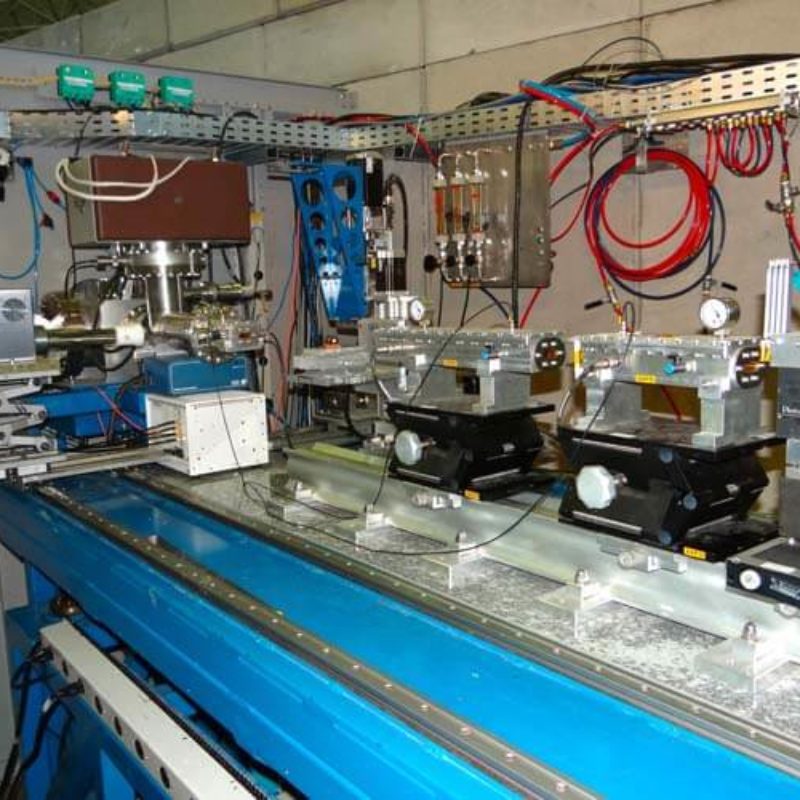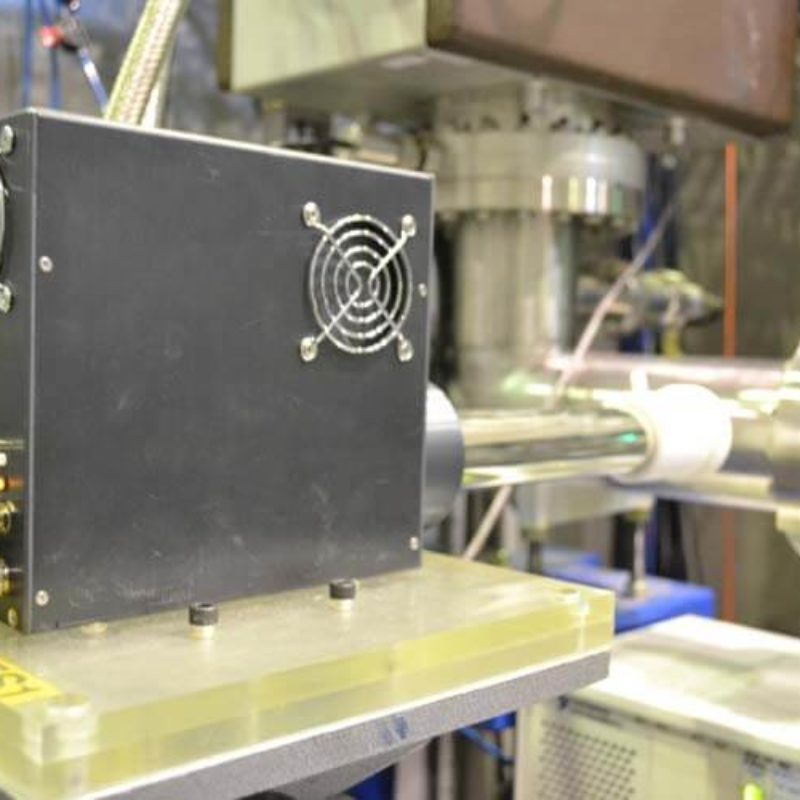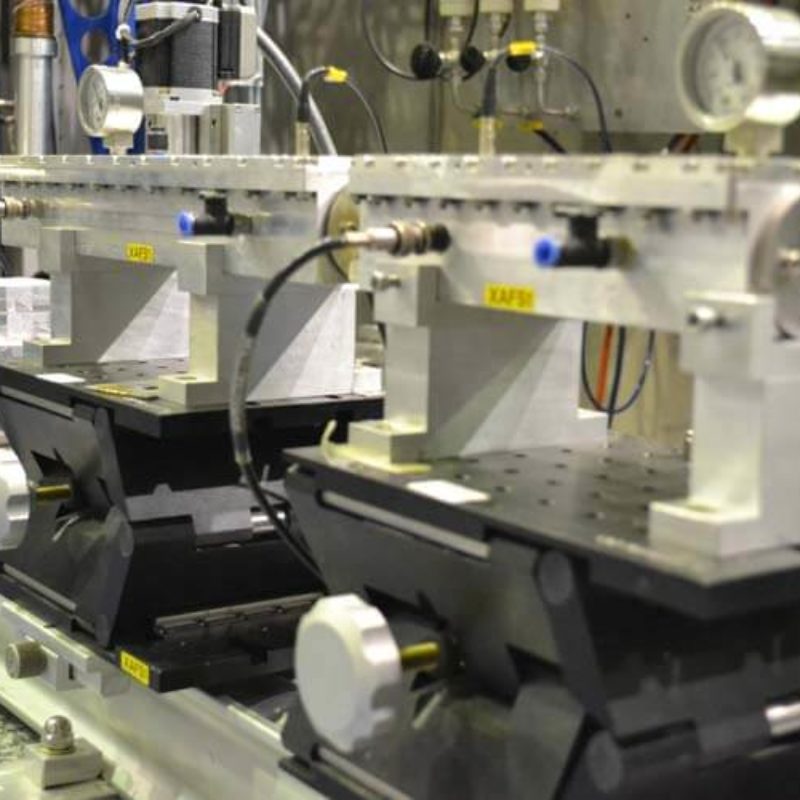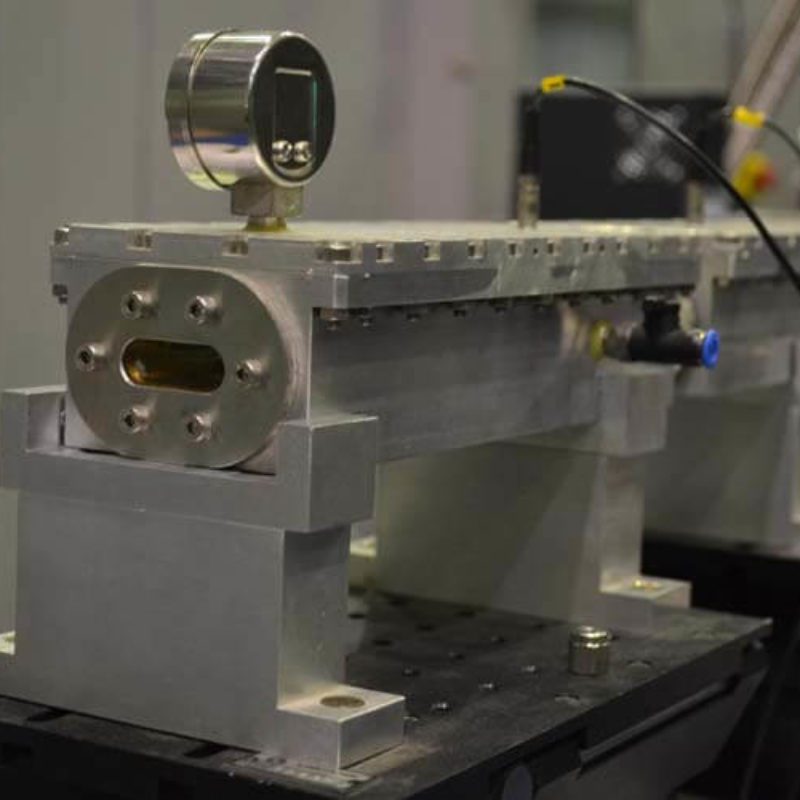CONTACT & STAFF
For more information on this beamline, contact us.
The XAFS1 beamline is an experimental station dedicated to X-ray Absorption Spectroscopy in the hard x-rays energy range (4 to 23 keV). This beamline is used in the study of the atomic-level structure as well as in the electronic and magnetic properties of matter, finding applications in a wide range of scientific fields, such as materials science and solid state physics, chemistry, earth sciences and biology. Available techniques include high-edge resolution (XANES) and fine structure spectroscopy (EXAFS).
The XAFS1 is a 1.67T bending magnet beamline open to users since July 1997. At the second semester of 2016, this beamline was closed for external users and is conditionally available through Fast Track operation and since then XAS spectra can be collected only in transmission mode.
For usual transmission-mode experiments, three chambers are used. The first one is coupled to the beamline, the second is used for detecting the signal after the sample, and the third is used for measuring a reference sample or doubling the data set. Some sample environments as cryostats, and inert gas chambers are available to users at the XAFS1 beamline.
The experimental station is equipped with a granite table, supporting a 1.60 m long rail aligned to the beam direction on which are mounted an XY remote-controlled sample holder, the detectors, and experimental facilities. The granite table can withstand a maximum weight of 300 kg, and track the vertical position of the beam with an accuracy of 1 mm over a 120 mm stroke. In order to keep the beam spot at the same position on the sample, this track is performed automatically during an energy scan, in fact, the changes in beam offset are important only for rather low energies for most applications, i.e. above 8 keV, the tracking is blocked.
For more information on this beamline, contact us.
The following experimental techniques and setups are available to users in this beamline. To learn more about the techniques’ limitations and requirements (sample, environment, etc.) contact the beamline coordinator before submitting your proposal.
X-ray absorption spectroscopy (XAS) is a widely used technique for determining the local geometric and/or electronic structure of matter and long range structural changes.
Today, the standard beamline setup allows experiments only in transmission mode. For transmission experiments, three ionization chambers are filled with optimal He, N2 and/or Ar gas mixtures at a total pressure of 1.5 bars. The signals of the ionization chambers are amplified by Stanford picoammeters and digitalized by a voltage to frequency converter before being read by the counters at the PXI-NI.
Recent publications using this setup:
J. C. Sczancoski, W. Avansi, M. G. S. Costa, M. Siu Li, V. R. Mastelaro, R. S. Santos, E. Longo, L. S. Cavalcante. Journal of Materials Science, 50(24) (2015) 8089-8103.
Jocenir Boita, Fabiano Bernardi, Marcus Vinícius Castegnaro, Lucas Nicolao, Maria C. M. Alves, and Jonder Morais. J. Phys. Chem. C, 118 (2014) 5538−5544.

| Element | Type | Position [m] | Description |
|---|---|---|---|
| Source | Bending Magnet | – | Bending Magnetic D04 exit B (15°), 1.67T, |
| Pre-mono Slits | Two UHV slit systems – vertically and horizontally – based on four independent mechanical feedthroughs, each one supporting at its ends a Ta blade mounted on a copper block. | 6.5 | Two water-cooled slits system. Vertically sets the resolution of the beam profile at sample holder. |
| Mono | Channel-cut Crystal | 7.7 | water-cooled Si(111) and Si(220) |
| Post-mono Slits | Two UHV slit systems – vertically and horizontally – based on four independent mechanical feedthroughs, each one supporting at its ends a Ta blade mounted on a copper block. | 9.2 | Without refrigeration, these slits are used to eliminate the spurious background radiation. |
| Parameter | Value | Condition |
|---|---|---|
| Energy range [keV] | 4-23 | Si(111), Si (220) |
| Energy resolution [ΔE/E] | 1.31 x 10-4 | Si (111) |
| Energy resolution [ΔE/E] | 5.37 x 10-5 | Si (220) |
| Beam size at sample [µm2, FWHM] | ~1000 x 1000 | at 10 keV |
| Beam divergence at sample [mrad2, FWHM] | 1 x 0.1 | at 10 keV |
| Flux density at sample [ph/s/mm2] | 109 | at 7 keV, Si (111) |
| Flux density at sample [ph/s/mm2] | 108 | at 7 keV, Si (220) |
| Harmonic content | <1% | For E>5 keV |
| Instrument | Type | Model | Manufacturer | Specifications |
|---|---|---|---|---|
| Detector | Ion chambers | – | Two electrodes in a distance of 14 mm. Length of 137 mm, 221 mm and 381 mm. A 25 µm kapton window with a in/out area of 12 x 30 mm2 | LNLS in-house development |
| Cryostats | Cooling power He closed cycle cryocooler | DE-202 Cryocooler series | (T min = 4 K) | ARSCryo |
| Inert Gas or Vacuum Chamber | – | – | Helium, Argon, Nitrogen or Vacuum ambient under flow or sealed | LNLS in-house development |
All beamline controls are done through EPICS (Experimental Physics and Industrial Control System), running on a PXI from National Instruments and communicates with Galil/Parker controllers. The beamline controls and data acquisition are made by a linux workstation running Spec. For user-friendly interface in Motif Editor and Display Manager (MEDM) is used as a graphical interface to display and control the beamline devices.
Click here to download the XAFS1 beamline manual (in portuguese).
Users are required to acknowledge the use of LNLS facilities in any paper, conference presentation, thesis and any other published material that uses data obtained in the execution of their proposal.
TOLENTINO, H. C. N.; RAMOS, A. Y.; ALVES, M. C. M.; BARREA, R. A.; TAMURA, E. ; CEZAR, J. C.; WATANABE, N. A 2.3 to 25 KeV XAS beamline at LNLS. Journal of Synchrotron Radiation, 8: 1040-6 (2001). doi:10.1107/S0909049501005143.
The LNLS XAS beamline has been operating for external users since July 1997. Many facilities and improvements have been progressively added to it, extending the range of applications. Here, a technical description of the main beamline components is given, and results concerning important points, such as available flux at low and high energies, harmonic contamination, energy resolution and stability, are presented. Some key results are given to demonstrate the beamline performance and limitations. It is shown that the beamline can cover a large energy range, starting from the rather low energy of 2.3 keV up to 25 keV.
A.Y. RAMOS, H. TOLENTINO, M.C.M. ALVES. Energy Resolution at LNLS-XAS beam line LNLS Technical Memorando Met-01/00 , Campinas, p1-8, 2000. Clique aqui para Download.
We recall here the main parameters determining the energy resolution in an XAS measurement and the experimental characteristics of the LNLS-XAS beam line necessary to a correct evaluation ofthis resolution. The XAS beam line has been designed to be used from 2.5 up to 24 keV. At low energy (<6keV) all terms contributing to resolution are of the same order. Above 6keV the resolution is principally limited by the divergence of the beam for K-edge measurements and by the core level width for L-edge ones.
RAMOS, A.Y., TOLENTINO, H., BARREA, R., ALVES, M.C.M. Harmonic contamination for Si(111) monochromator at the XAS beam line – up to August 1999. LNLS Technical Memorando Met-01/99 , Campinas, p1-4, 1999. Clique aqui para Download.
An experimental measurement of the harmonic contamination for low energy transmission measurements with Si(111) channel-cut monochromator on the XAS beam line is reported. The ratio of flux due to the third order harmonic, measured with air-filled ion chamber is less than 0.1%, for energies above 4300eV and less than 1% for energies above 3900eV. Below 3900eV the harmonic contamination increases strongly and reaches values greater than10% below 3500eV.
TOLENTINO, H., CEZAR, J. C., CRUZ, D. Z., COMPAGNON-CAILHOL, V., TAMURA, E. & MARTINS ALVES, M. C.(1998). J. Synchrotron Rad. 5, 521-523. doi:10.1107/S0909049597015264.
An X-ray absorption fine-structure spectroscopy beamline has been installed and commissioned at a bending-magnet source at LNLS. Three monochromators are available: a channel-cut, a double-crystal and a four-crystal set-up. They have been operated from 2500 up to 15000 eV, with a resolving power better than 5500 in the full range. Photon flux of the order of 10^8 photons s^{-1} up to 10^{10} photons s^{-1} has been attained. The experimental station is equipped with a table that can withstand a weight of 300 kg and track the vertical position of the beam with a 2.5 µm accuracy over a 120 mm stroke. The beamline has been fully characterized and the first results are presented.
Scientific publications produced with data obtained at the facilities of this beamline, and published in journals indexed by the Web of Science, are listed below.
Biazati, L. B. ;Lorenzini, L. ;Ferreira, S. A. D.;Porto, A. O.;Castro, E. V. R. de;Fabris, J. D.;Freitas, M. B. J. G. ;Lelis, M. F. F.. Influence of the Local Structure on the Photocatalytic Properties of Zinc Spinel Ferrite Nanoparticles, Journal of the Brazilian Chemical Society, v.33, n.2, p.135-142, 2022. DOI:10.21577/0103-5053.20210130
Salvador, A. J. ;Neckel, I. T.;Graff, I. L.;Mosca, D. H.. Chemical disorder in polycrystalline Ni2MnGa thin films, Journal of Alloys and Compounds, v. 898, p.162970, 2022. DOI:10.1016/j.jallcom.2021.162970
Cavichini, A. S.;Orlando, M. T. D.;Fantini, M. C. de A.;Tartaglia, R. ;Galdino, C. W. ;Damay, F.;Porcher, F.;Granado, E.. Enhanced magnetism and suppressed magnetoelastic coupling induced by electron doping in Ca1-xYxMnReO6, Journal of Physics-Condensed Matter, v.34, n.4, p.245803, 2022. DOI:10.1088/1361-648X/ac61b5
Praxedes, F. M. ;Moreno, H. P. ;Simões, A. Z. ;Teixeira, V. C.;Nunes, R. S. ;Amoresi, R. A. C. ;Ramírez, M. A.. Interface matters: Design of an efficient CaCu3Ti4O12-rGO photocatalyst, Powder Technology, v.404, p.117478, 2022. DOI:10.1016/j.powtec.2022.117478
Callefo, F. ;Ricardi-Branco, F.;Pacheco, M. L. A. F.;Cardoso, A. R. ;Noffke, N. ;Teixeira, V. C.;Neckel, I. T.;Maldanis, L.;Bullock, E. S. ;Bower, D. M. ;Silva, A. M. ;Sanchez, D. F.;Rodrigues, F.;Galante, D.. Evidence for metabolic diversity in Meso-Neoproterozoic stromatolites (Vazante Group, Brazil), Frontiers in Earth Science, v.10, p.804194, 2022. DOI:10.3389/feart.2022.804194
Martins, F. H.; Paula, F. L. O.; Gomes, R. C.; Gomes, J. A.; Aquino, R.; Porcher, F.; Perzynski, R.; Depeyrot, J.. Local Structure Investigation of Core-Shell CoFe2O4@gamma-Fe2O3 Nanoparticles, Brazilian Journal of Physics, v.51, p. 47–59, 2021. DOI:10.1007/s13538-020-00829-9
Moreno, H.; Cortes, J. A. ; Praxedes, F. M. ; Freitas, S. M. de; Rezende, M. V. dos S.; Simões, A. Z. ; Teixeira, V. C.; Ramírez, M. A.. Tunable photoluminescence of CaCu3Ti4O12 based ceramics modified with tungsten, Journal of Alloys and Compounds, v.850, p. 156652, 2021. DOI:10.1016/j.jallcom.2020.156652

Português:
Visão geral da Linha de Luz XAFS1.
English:
Overview of the XAFS1 beamline.

Português:
Detector de fluorescência (VORTEX) na Linha de Luz XAFS1.
English:
Fluorescence Detector (VORTEX) at the XAFS1 beamline.

Português:
Câmaras de ionização na mesa experimental da linha de luz XAFS1.
English:
Ionization chambers at the XAFS1 beamline.

Português:
Detalhe das câmaras de ionização da linha de luz XAFS1.
English:
Ionization chambers at the XAFS1 beamline.